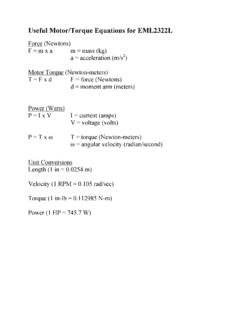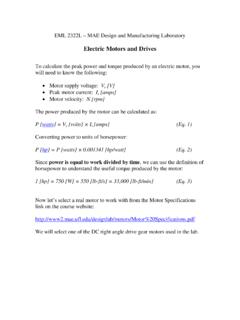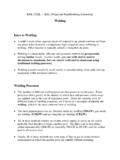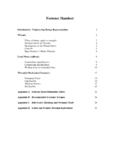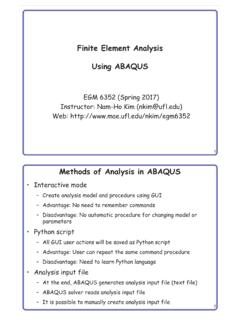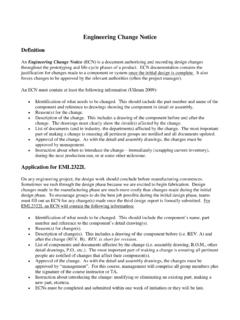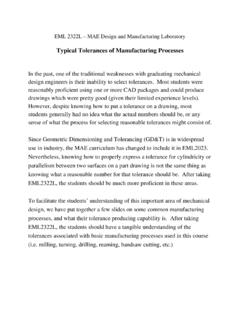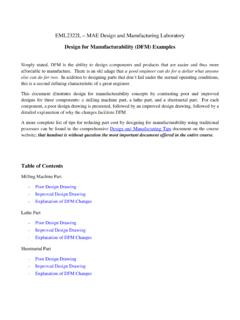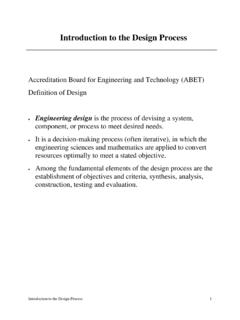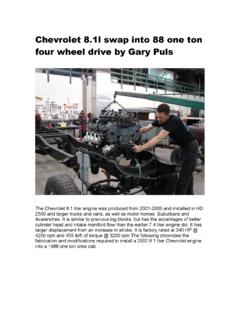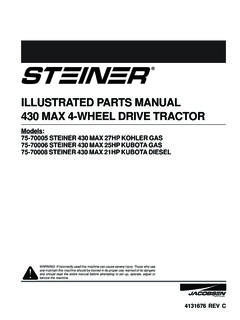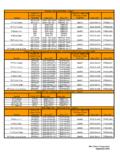Transcription of Drive Wheel Motor Torque Calculations - UFL MAE
1 EML2322L MAE Design and Manufacturing Laboratory Drive Wheel Motor Torque Calculations Reference Citation: White Hydraulics Drive Products When selecting Drive Wheel motors for mobile vehicles, a number of factors must be taken into account to determine the maximum Torque required. The following example presents one method of computing this Torque . Example vehicle design criteria: Gross vehicle weight (GVW): 35 lb Weight on each Drive Wheel (WW): 10 lb Radius of Wheel /tire (Rw): 4 in Desired top speed (Vmax): ft/sec Desired acceleration time (ta): 1 sec Maximum incline angle ( ): 2 degree Worst working surface: concrete (good) To choose motors capable of producing enough Torque to propel the example vehicle, it is necessary to determine the total tractive effort (TTE) requirement for the vehicle: TTE [lb] = RR [lb] + GR [lb] + Fa [lb] where.
2 TTE = total tractive effort [lb] RR = force necessary to overcome rolling resistance [lb] GR = force required to climb a grade [lb] Fa = force required to accelerate to final velocity [lb] The components of this equation will be determined in the following steps. Step One: Determine Rolling Resistance Rolling Resistance (RR) is the force necessary to propel a vehicle over a particular surface. The worst possible surface type to be encountered by the vehicle should be factored into the equation. RR [lb] = WGV [lb] x Crr [-] where: RR = rolling resistance [lb] WGV = gross vehicle weight [lb] Csf = surface friction coeff.
3 (value from Table 1) Example: RR = 35 lb x (good concrete) = lb Table 1: Surface Friction Coeff. for Plastic Wheels Contact Surface Csf Concrete (good / fair / poor) .010 / .015 /.020 Asphalt (good / fair / poor) .012 / .017 / .022 Wood (dry/dusty/wet) .010 / .005 / .001 Snow (2 inch / 4 inch) .025 / .037 Dirt (smooth / sandy) .025 / .037 Mud (firm / medium / soft) .037 / .090 / .150 Grass (firm / soft) .055 / .075 Sand (firm / soft / dune) .060 / .150 / .300 Step Two: Determine Grade Resistance Grade Resistance (GR) is the amount of force necessary to move a vehicle up a slope or grade.
4 This calculation must be made using the maximum angle or grade the vehicle will be expected to climb in normal operation. To convert incline angle, , to grade resistance: GR [lb] = WGV [lb] x sin( ) where: GR = grade resistance [lb] WGV = gross vehicle weight [lb] = maximum incline angle [degrees] Example: GR = 35 lb x sin(2 ) = lb Step Three: Determine Acceleration Force Acceleration Force (Fa) is the force necessary to accelerate from a stop to maximum speed in a desired time. Fa [lb] = WGV [lb] x Vmax [ft/s] / ( [ft/s2] x ta [s]) where: Fa = acceleration force [lb] WGV = gross vehicle weight [lb] Vmax = maximum speed [ft/s] ta = time required to achieve maximum speed [s] Example: Fa = 35 lb x ft/s / ( ft/s2 x 1 s) = lb EML2322L MAE Design and Manufacturing Laboratory Drive Wheel Motor Torque Calculations Step Four: Determine Total Tractive Effort The Total Tractive Effort (TTE) is the sum of the forces calculated in steps 1, 2, and 3.
5 (On higher speed vehicles friction in Drive components may warrant the addition of 10%-15% to the total tractive effort to ensure acceptable vehicle performance.) TTE [lb] = RR [lb] + GR [lb] + FA [lb] Example: TTE = lb + lb + lb = lb Step Five: Determine Wheel Motor Torque To verify the vehicle will perform as designed in regards to tractive effort and acceleration, it is necessary to calculate the required Wheel Torque (Tw) based on the tractive effort. Tw [lb -in] = TTE [lb] x Rw [in] x RF [-] where: Tw = Wheel Torque [lb-in] TTE = total tractive effort [lb] Rw = radius of the Wheel /tire [in] RF = resistance factor [-] The resistance factor accounts for the frictional losses between the caster wheels and their axles and the drag on the Motor bearings.
6 Typical values range between and (or 10 to 15%). Example: Tw = lb x 4 in x = 14 lb-in Step Six: Reality Check The final step is to verify the vehicle can transmit the required Torque from the Drive Wheel (s) to the ground. The maximum tractive Torque (MTT) a Wheel can transmit is equal to the normal load times the friction coefficient between the Wheel and the ground times the radius of the Drive Wheel . MTT = Ww [lb] x [-] x Rw [in] where: Ww = weight (normal load) on Drive Wheel [lb] s = static friction coefficient between the Wheel and the ground (~ for plastic on dry wood) [-] Rw = radius of Drive Wheel /tire [in] Example: MTT = 10 lb x x 4 in = 16 lb-in Interpreting Results: Total Tractive Effort is the net horizontal force applied by the Drive wheels to the ground.
7 If the design has two Drive wheels, the force applied per Drive Wheel (for straight travel) is half of the calculated TTE. The Wheel Torque calculated in Step Five is the total Wheel Torque . This quantity does not change with the number of Drive wheels. The sum of the individual Drive Motor torques (see Motor Specifications) must be greater than or equal to the computed Wheel Torque . The Maximum Tractive Torque represents the maximum amount of Torque that can be applied before slipping occurs for each Drive Wheel . The total Wheel Torque calculated in Step Five must be less than the sum of the Maximum Tractive Torques for all Drive wheels or slipping will occur.
8 Estimating Parameters For these Calculations to be meaningful, appropriate parameters should be chosen. Typical ranges for robot designs are provided below. Note an appropriate acceleration time must be chosen such that the required Tw < MTT number of Drive wheels. Typical EML2322L vehicle design criteria: Gross vehicle weight (WGV): 20 40 lb Weight on each Drive Wheel (Ww): 5 15 lb Radius of Wheel /tire (Rw): 2 in Desired top speed (Vmax): Speed Calcs Desired acceleration time (ta): 2 sec Max incline angle ( ): 1 3 degree Worst working surface: concrete (good) Number of Drive wheels: 2
